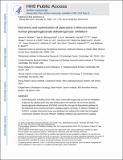Discovery and optimization of piperazine-1-thiourea-based human phosphoglycerate dehydrogenase inhibitors
Author(s)
Rohde, Jason M.; Brimacombe, Kyle R.; Liu, Li; Pacold, Michael Edward; Yasgar, Adam; Cheff, Dorian M.; Lee, Tobie D.; Rai, Ganesha; Baljinnyam, Bolormaa; Li, Zhuyin; Simeonov, Anton; Hall, Matthew D.; Shen, Min; Sabatini, David; Boxer, Matthew B.; ... Show more Show less
DownloadAccepted version (2.074Mb)
Publisher with Creative Commons License
Publisher with Creative Commons License
Creative Commons Attribution
Terms of use
Metadata
Show full item recordAbstract
Proliferating cells, including cancer cells, obtain serine both exogenously and via the metabolism of glucose. By catalyzing the first, rate-limiting step in the synthesis of serine from glucose, phosphoglycerate dehydrogenase (PHGDH) controls flux through the biosynthetic pathway for this important amino acid and represents a putative target in oncology. To discover inhibitors of PHGDH, a coupled biochemical assay was developed and optimized to enable high-throughput screening for inhibitors of human PHGDH. Feedback inhibition was minimized by coupling PHGDH activity to two downstream enzymes (PSAT1 and PSPH), providing a marked improvement in enzymatic turnover. Further coupling of NADH to a diaphorase/resazurin system enabled a red-shifted detection readout, minimizing interference due to compound autofluorescence. With this protocol, over 400,000 small molecules were screened for PHGDH inhibition, and following hit validation and triage work, a piperazine-1-thiourea was identified. Following rounds of medicinal chemistry and SAR exploration, two probes (NCT-502 and NCT-503) were identified. These molecules demonstrated improved target activity and encouraging ADME properties, enabling in vitro assessment of the biological importance of PHGDH, and its role in the fate of serine in PHGDH-dependent cancer cells. This manuscript reports the assay development and medicinal chemistry leading to the development of NCT-502 and -503
reported in Pacold et al. (2016). Keywords: PHGDH; inhibitor; serine
Date issued
2018-05Department
Massachusetts Institute of Technology. Department of Biology; Koch Institute for Integrative Cancer Research at MITJournal
Bioorganic & Medicinal Chemistry
Publisher
Elsevier BV
Citation
Rohde, Jason M. et al. “Discovery and Optimization of Piperazine-1-Thiourea-Based Human Phosphoglycerate Dehydrogenase Inhibitors.” Bioorganic & Medicinal Chemistry 26, 8 (May 2018): 1727–39.
Version: Author's final manuscript
ISSN
0968-0896